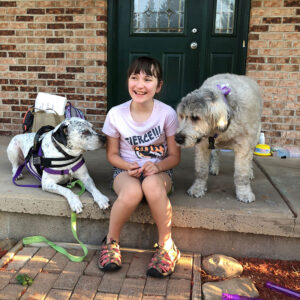Things like remote learning and masks make things difficult for a student with autism
By Deborah Jeanne Sergeant

The COVID-19 pandemic has brought a plethora of changes to everyday life, including to children newly educating at home.
For children with autism spectrum disorder (ASD), learning in the classroom was already challenging. Filtering lessons through Zoom or other remote means adds an additional layer of difficulty.
Jen Hackett, a teacher with Webster Central School District, teaches children with ASD as part of the virtual team. She calls remote learning “very challenging.”
Hackett is also executive director of Camp Puzzle Peace, Inc., headquartered in Penfield.
“The lack of socialization for these kids is huge,” Hackett said. “For many kids with ASD, they struggle with socialization and interacting with others.”
Schooling at home may seem a big relief and a welcomed retreat. However, Hackett said that is not what they need.
“Face to face schools forces them to interact with others and be social,” she said. “We are greatly concerned the impact the isolation will have on them.”
Heather Burroughs, a Hilton resident, knows that all too well. Her daughter, Devyn Pereira, has autism. The 14-year-old had been learning at home through Hilton Central School District.
“With remote learning for Devyn, you might as well not do it,” Burroughs said. “She will tune into what’s important to her like her music therapist playing a song, but she’d much rather be in person. On the screen, it’s like a boring video they’re making her watch.”
Devyn is not verbal, which makes it even tougher for her to learn remotely.
Burroughs is thankful that the school district allowed her daughter to go back to school five days a week. Otherwise, Burroughs feared her daughter would begin to lose her hard-earned skills. Going through the pandemic has been hard enough on her education and socialization.
“Not being able to go to stores and restaurants and practice skills has been a big deal,” Burroughs said. “All children benefit from the social experience, but for children with autism, they need extra opportunities to practice skills.”
Burroughs directs the behavioral health team at Monroe Community Hospital and has previously worked with children with disabilities in a school setting for 15 years.
Some children on the autism spectrum struggle to understand appropriate social interactions. Changing the “rules” because of the pandemic confuses matters further.
“Now having social distancing, they’ll never be as able to accept a kind gesture like a high five or pat on the back,” Burroughs said. “’Those things aren’t important’ is what they’ll start to think. I worry for kids with autism now. Once they learn something a certain way, it’s hard to change.”
Burroughs said that her daughter’s classroom team has worked to help send home materials as needed. But while she educated Devyn at home, it was difficult for Burroughs to instinctively mimic the teaching methods that her teachers were using at school.
“I don’t want to undo anything,” she said. “A lot of times, remote learning was me and one of her aids at home. She has people with her all the time; they were teaching us to teach her. You don’t want to do it wrong.”
Burroughs said that learning at home is also confusing to children accustomed to attending school because home should be where they relax, have fun and unwind.
Even though Devyn is back at class, it’s still difficult. Though Devyn is not deaf, she relies on facial expressions to help process what is spoken. The presence of the masks — both in muffling speech and obscuring the speaker’s face — adds yet another layer of barrier for Devyn to work through in addition to the other stimuli that are not miniscule to her.
“If the light is buzzing, her shirt’s tag is itchy or her sock is crooked, those things are all distracting for a kid with autism,” Burroughs said. “It makes it 10 times harder for them to understand the situation.”

